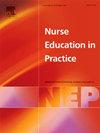使用虚拟病人模拟和部分任务训练器:准实验研究
IF 3.3
3区 医学
Q1 NURSING
引用次数: 0
摘要
背景护理专业学生需要能提供足够知识和实践机会的教育方法来提高他们的技能。目的分析将部分任务培训师纳入虚拟患者的益处,重点关注高年级护理专业学生在为急性尿潴留患者导尿时的效果、表现、自信心、满意度和知识得分。方法该研究于 2023 年 4 月至 5 月在护理学院进行,共有 71 名高年级护理专业学生参加:虚拟患者组(I 组)35 人,虚拟患者和部分任务培训师组(II 组)36 人。收集数据的方法如下结果 I 组的满意度和自信心得分分别为 4.67(SD 0.49)和 4.38(SD 0.48),而 II 组的满意度和自信心得分分别为 4.88(SD 0.22)和 4.70(SD 0.34)。差异具有统计学意义(P<0.05)。在模拟效果工具方面,第一组的信心子维度得分为 31.05(标准差 3.28),总分为 85.05(标准差 7.37);第二组的信心子维度得分为 32.57(标准差 2.73),总分为 88.48(标准差 6.60)。这些差异具有统计学意义(P<0.05)。在模拟效果工具的汇报前、学习和汇报子维度上,各组之间没有发现明显差异(p>0.05)。表现和知识得分也无明显差异(p>0.05)。结论结果表明,使用虚拟病人和部分任务培训师可提高学生的满意度和自信心,并被认为是对急性尿潴留病人进行护理干预的有效方法。本文章由计算机程序翻译,如有差异,请以英文原文为准。
Using virtual patient simulation with partial task trainer: A quasi-experimental study
Background
Nursing students need educational approaches that provide sufficient knowledge and practice opportunities to improve their skills.
Aim
To analyze the benefits of incorporating partial task trainers into virtual patients, focusing on the effectiveness, performance, self-confidence, satisfaction and knowledge scores among senior nursing students in urinary catheterization for patients with acute urinary retention.
Design
A randomized, quasi-experimental design.
Methods
The study was conducted at a nursing faculty between April-May 2023 with 71 senior nursing students: 35 in the virtual patient group (Group I) and 36 in the virtual patient and partial task trainer group (Group II). The data were gathered using: Personal Information Form, Student Satisfaction and Self-confidence in Learning Scale, Simulation Effectiveness Tool, Performance Report and Knowledge Report.
Results
The satisfaction and self-confidence scores for Group I were 4.67 (SD 0.49) and 4.38 (SD 0.48), whereas Group II scored 4.88 (SD 0.22) and 4.70 (SD 0.34), respectively. The differences were statistically significant (p<0.05). For the Simulation Effectiveness Tool, Group I scored 31.05 (SD 3.28) for confidence subdimension and 85.05 (SD 7.37) for the total score, whereas Group II scored 32.57 (SD 2.73 and 88.48 (SD 6.60), respectively. These differences were statistically significant (p<0.05). No significant differences were found between the groups in the prebriefing, learning and debriefing subdimensions of the Simulation Effectiveness Tool (p>0.05). Performance and knowledge scores also showed no significant differences (p>0.05). Effect sizes for all statistically significant differences were moderate.
Conclusions
The results show that using virtual patients with partial task trainers increases students’ satisfaction and self-confidence and is perceived as effective in developing nursing interventions for patients with acute urinary retention.
求助全文
通过发布文献求助,成功后即可免费获取论文全文。
去求助
来源期刊

Nurse Education in Practice
NURSING-
CiteScore
5.40
自引率
9.40%
发文量
180
审稿时长
51 days
期刊介绍:
Nurse Education in Practice enables lecturers and practitioners to both share and disseminate evidence that demonstrates the actual practice of education as it is experienced in the realities of their respective work environments. It is supportive of new authors and will be at the forefront in publishing individual and collaborative papers that demonstrate the link between education and practice.
 求助内容:
求助内容: 应助结果提醒方式:
应助结果提醒方式:


